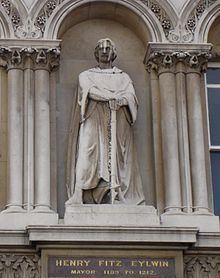Preceded by New title Religion Roman Catholic Occupation first Mayor of London | Nationality English Succeeded by Roger Fitzalan Name Henry de | |
 | ||
Children Peter Fitz-Henry
Alan Fitz-Henry
Thomas Fitz-Henry
Richard Fitz-Henry Died September 19, 1212, London, United Kingdom | ||
Henry fitz Ailwin (about 1135 – 19 September 1212) was an English businessman and landowner who served as the first Mayor of the City of London (the title becoming Lord Mayor of London from 1347 and then Lord Mayor of the City of London from 2006). In office from about 1189 until his death in 1212, he was the only mayor to hold the post for life .
Contents
Origins
Of English descent, rather than Norman, his family had been active in the commercial and civic life of London for generations. His grandfather Leofstan (died about 1115) was probably the portreeve of London, who in 1108 was involved in the foundation of Holy Trinity Priory, Aldgate. The house of his father Ailwin (died 1164/5) was where the husting court of London met and his uncle Robert was an official of the weavers' guild in 1130.
Career
Little is known of his business interests, which probably centred on making, finishing, and selling cloth. In politics, he was an alderman by 1168 and became one of the most influential men in the city. Under King Richard I and his brother King John, the royal need to raise finance from London businessmen resulted in the grant of greater autonomy to the city, which previously had been governed by a portreeve, an officer of the crown. Instead, the office of mayor emerged, with fitz Ailwin first named as such in 1194.
In 1193 he was one of the those entrusted with the money collected for the King's ransom and in 1208 negotiated for the use of ground outside the walls as a city burial ground. After the great fire of 1212, he and other city officials issued a code governing new building.
He gave generously to church causes, with endowments to Holy Trinity Priory, St Bartholomew's Hospital, Westminster Abbey, the Chapel of St Thomas on the Bridge completed in 1209, and to the nunneries of St Mary, Clerkenwell and Godstow. He contributed to the foundation of St Mary Spital and at Watton-at-Stone was remembered as the founder of a chapel.
He died on 19 September 1212 and was buried in Holy Trinity Priory, where his tomb could still be seen in the sixteenth century. There was also a memorial to him in the church of St Mary Bothaw.
Landholdings
In 1165 he and his brother Alan inherited their father's lands, probably those at Watton-at-Stone in Hertfordshire, which became his country home. He also had properties at Edmonton in Middlesex, in Surrey, and beside the Thames in Kent. In London, his business headquarters were on what was then called Candlewick Street, now Cannon Street, and he also owned many premises in the eastern half of the city.
Family
His widow was named Margaret and was probably the mother of his four sons: Peter, Alan, Thomas and Richard. Peter, the eldest, married Isabel, daughter of Bartholomew de Chesney, of Addington, Surrey, and died in 1211 before his father. His heiress was his daughter Joan, who also inherited the assets of her three uncles. She married William Aguillon and in 1235 was the mother of Sir Robert Aguillon.
